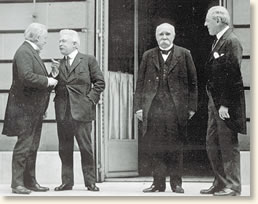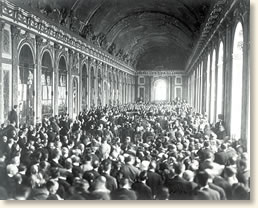|
Signing the Treaty of Versailles,
1919
The Paris Peace Conference began on January 18, 1919, with 21 nations in attendance. The representatives of Germany and the other defeated Central Powers were not allowed to sit at the conference table. The "Big Four" - President Wilson of the United States, Prime Minister Lloyd George of Great Britain, Prime Minister Georges Clemenceau of France and Prime Minister Vittorio Orlando of Italy - dominated the conference and made the important decisions. Wilson pushed for inclusion of his Fourteen Points especially the League of Nations. Many of his proposals, however, clashed with the secret treaties and territorial rearrangements already made by the other three European powers. The three European leaders found it difficult to hide their contempt for what they saw as Wilson's naivete and superior attitude.
 |
The Big 4 at Versailles - Lloyd George,
Orlando, Clemenceau, and Wilson
|
France's primary objective was to ensure her security. In 1814, 1815, 1870, and again in 1914, German armies had swarmed across France's borders. France sought a peace treaty that would assure that her homeland would never again be invaded by her German neighbor. Additionally, as the war had been fought on French soil, the French looked to the Germans to pay for the restoration of her devastated homeland.
The political wrangling became intense. At one point Wilson had to step between Lloyd George and Clemenceau to prevent a fist fight. At another time Wilson threatened to leave the conference. Orlando did leave for a time. Finally, agreement was reached and a treaty presented to the German representatives on May 7, 1919. The terms were harsh. Germany was stripped of approximately 13% of its pre-war territory and all of its over-seas possessions. The Ruhr - Germany's industrial heartland - was to be occupied by allied troops. The size of Germany's military forces was drastically reduced. The treaty further stipulated that Germany would pay for the devastation of the war through annual reparation payments to its European neighbors. The victors ignored the bitter complaints of the German delegation.
On June 28, two rather obscure German representatives signed the treaty. Celebration erupted. The signing ceremony brought the curtain down on the final act of the Great War. No one present was aware that it also signaled the opening act of a conflict that would erupt twenty years later with even more terrible consequences.
Sir Harold Nicolson was a member of the British delegation to the Treaty of Versailles. He offers his observations of its signing on June 28, 1919:
"We enter the Galerie des Glaces (Hall of Mirrors). It is divided into three sections. At the far end are the Press already thickly installed. In the middle there is a horse-shoe table for the plenipotentiaries. In front of that; like a guillotine, is the table for the signatures. It is supposed to be raised on a dais but, if so, the dais can be but a few inches high...There must be seats for over a thousand persons. This robs the ceremony of all privilege and therefore of all dignity.
...the delegates arrive in little bunches and push up the central aisle slowly. Wilson and Lloyd George are among the last. They take their seats at the central table. The table is at last full. Clemenceau glances to right and left. People sit down upon their escabeaux but continue chattering. Clemenceau makes a sign to the ushers. They say 'Ssh! Ssh! Ssh!' People cease chattering and there is only the sound of occasional coughing and the dry rustle of programs. The officials of the Protocol of the Foreign Office move up the aisle and say, 'Ssh! Ssh!' again. There is then an absolute hush, followed by a sharp military order. The Gardes Republicains at the doorway flash their swords into their scabbards with a loud click. 'Faites entrer les Allemands,' says Clemenceau in the ensuing silence.
Through the door at the end appear two huissiers with silver chains. They march in single file. After them come four officers of France, Great Britain, America and Italy. And then, isolated and pitiable, come the two German delegates. Dr. Muller, Dr. Bell. The silence is terrifying. Their feet upon a strip of parquet between the savonnerie carpets echo hollow and duplicate. They keep their eyes fixed away from those two thousand staring eyes, fixed upon the ceiling. They are deathly pale. They do not appear as representatives of a brutal militarism. The one is thin and pink-eyelidded. The other is moon-faced and suffering. It is all most painful.
 |
| Signing the Treaty in the Hall of Mirrors |
They are conducted to their chairs. Clemenceau at once breaks the silence. 'Messieurs,' he rasps, 'la seance est ouverte.' He adds a few ill-chosen words. 'We are here to sign a Treaty of Peace.' The Germans leap up anxiously when he has finished, since they know that they are the first to sign. William Martin, as if a theatre manager, motions them petulantly to sit down again. Mantoux translates Clemenceau's words into English. Then St. Quentin advances towards the Germans and with the utmost dignity leads them to the little table on which the Treaty is expanded. There is general tension. They sign. There is a general relaxation. Conversation hums again in an undertone.
The delegates stand up one by one and pass onwards to the queue which waits by the signature table. Meanwhile people buzz round the main table getting autographs. The single file of plenipotentiaries waiting to approach the table gets thicker. It goes quickly. The Officials of the Quai d'Orsay stand round, indicating places to sign, indicating procedure, blotting with neat little pads.
Suddenly from outside comes the crash of guns thundering a salute; It announces to Paris that the second Treaty of Versailles has been signed by Dr. Muller and Dr. Bell. Through the few open windows comes the sound of distant crowds cheering hoarsely. And still the signature goes on.
We had been warned it might last three hours. Yet almost at once it seemed that the queue was getting thin. Only three, then two, and then one delegate remained to sign. His name had hardly been blotted before the huissiers began again their 'Ssh! Ssh!' cutting suddenly short the wide murmur which had again begun. There was a final hush. 'La seance est levee' rasped Clemenceau. Not a word more or less.
We kept our seats while the Germans were conducted like prisoners from the dock, their eyes still fixed upon some distant point of the horizon."
References:
Harold Nicolson's account appears in: Nicolson, Harold, Peacemaking, 1919 (1933); Elcock, Howard, Portrait of a Decision: The Council of Four and the Treaty of Versailles (1972); Goldberg, George, The Peace to End Peace; the Paris Peace Conference of 1919 (1969).
How To Cite This Article:
"Signing the Treaty of Versailles, 1919," EyeWitness to History, www.eyewitnesstohistory.com (2005).
|






